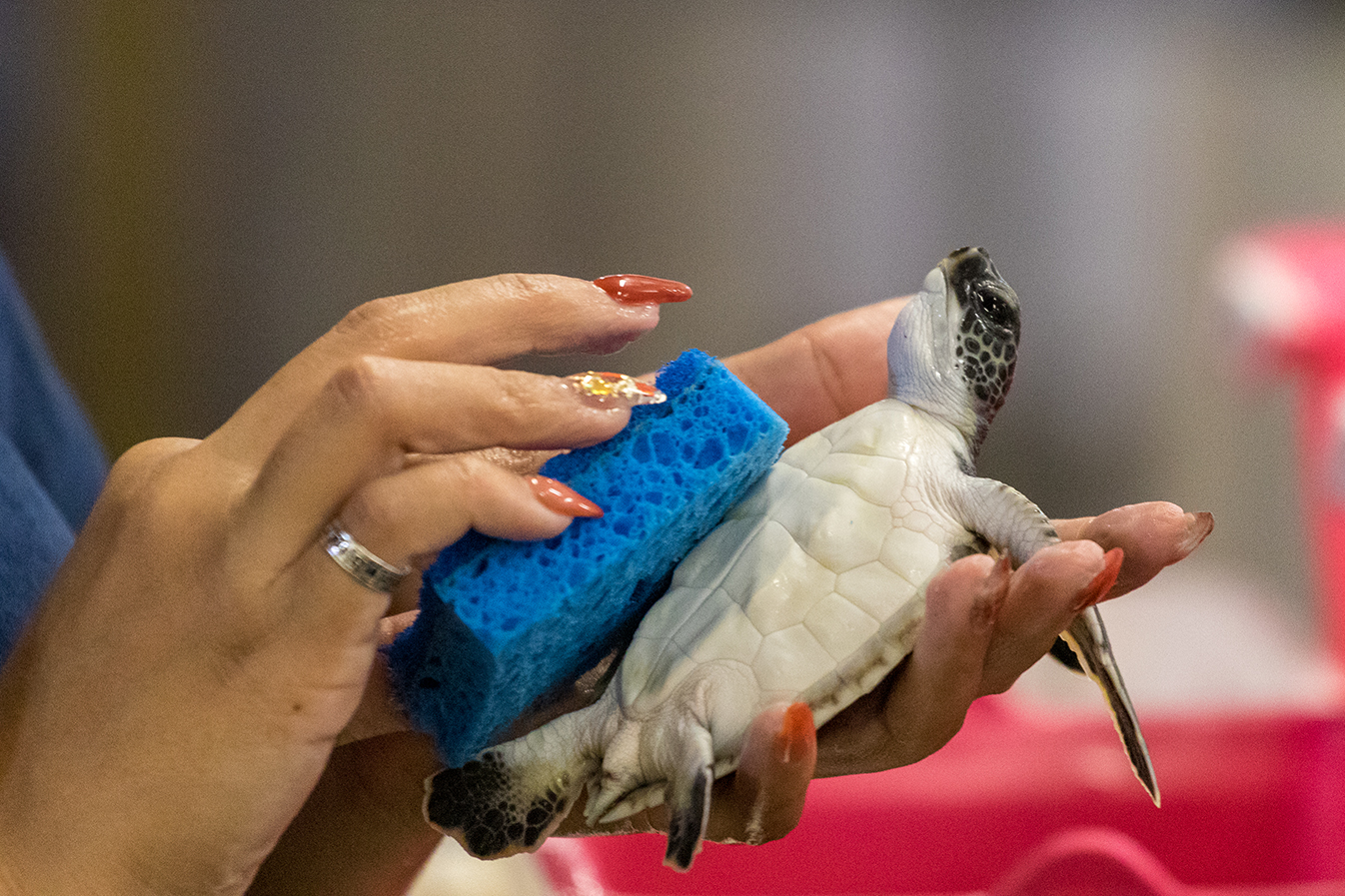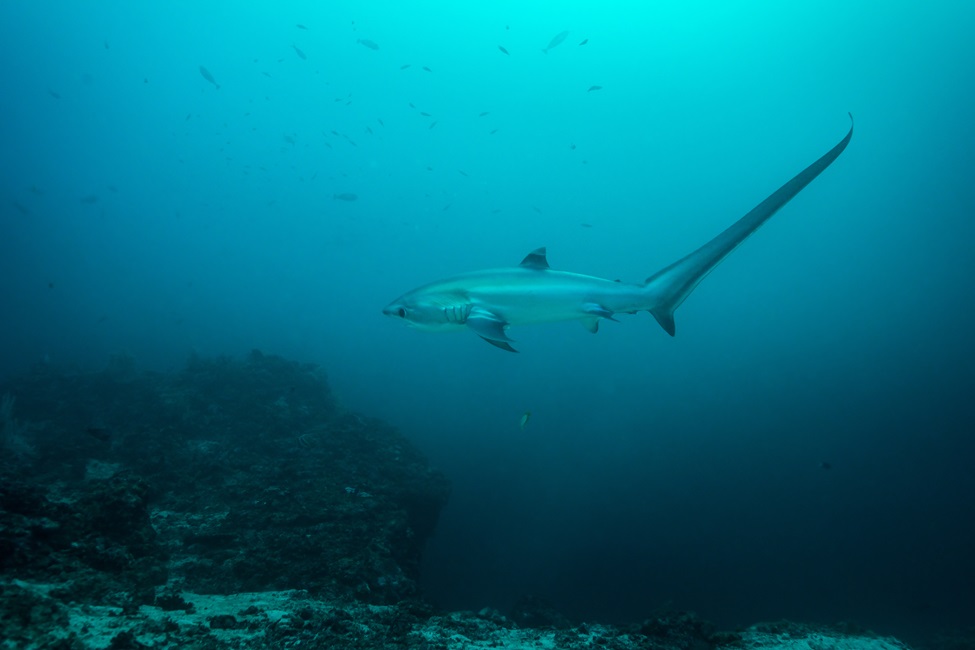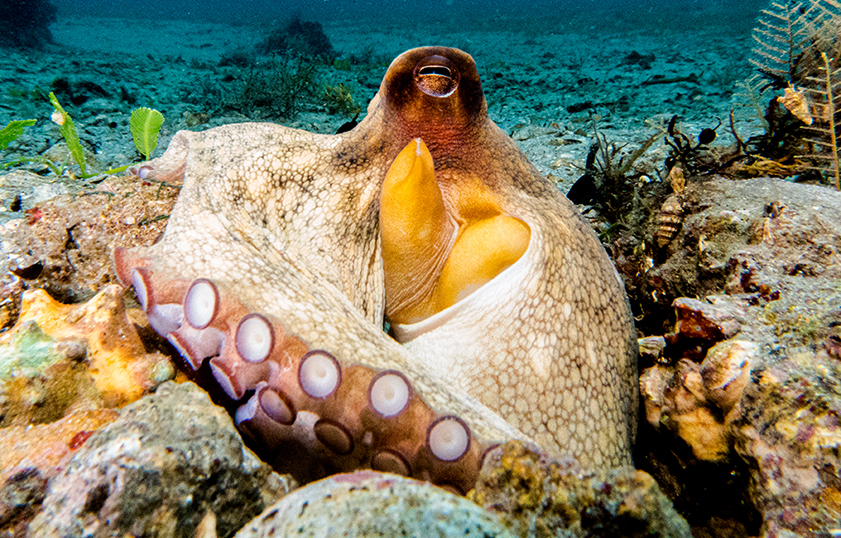
Author: Hannah Mauer
Date: October 25, 2024
|
It’s Spooky Season at the FAU Marine Lab! Many folks in our lab love the opportunity to masquerade as something else – graduate students have been known to feed turtles in ninja turtle costumes, Postdocs have dressed up like a deep-sea strawberry squid (complete with bejeweled light-producing organs!), and full professors have given entire lectures in Halloween garb. Even the animals we study at the FAU Marine Lab are already celebrating; in fact, they have several bags of tricks and enjoy many treats year-round! Read about the tricks and treats of sea turtles, sharks, and octopuses, below.
Are your eyes playing tricks on you or does that turtle look like it is heading to a formal gathering? No, but it might look like it! When green sea turtle hatchings first come into the lab, they almost appear to be wearing tiny tuxedos. The carapace (top shell) is black, and their plastron (bottom, or belly-side shell) is white. This is a trick known as countershading that helps the hatchlings hide from predators above and below. Predators from above see black like the darkness of the ocean below them. Predators from below see white like the lighter, dappled sunlit water above them. Many marine animals exhibit countershading, as both predators and prey are all trying to trick each other, just like on Halloween!
During their time in the Marine Lab our sea turtles are cared for using the best practices that improve every year as we continue to learn from each nesting season. One special treat for our small sea turtles is a weekly sponge bath! By lightly scrubbing them with sponges, students in the lab mimic cleaner fish that turtles will naturally encounter in the wild – a spa day treat for our marine visitors.

Thresher sharks might consider dressing up like Indiana Jones for Halloween. While sharks do not wear a fedora like this adventuring archeologist, they do have their own whip to add to their tricky costume! The thresher shark has a whip-like tail that it uses to stun prey as it hunts. This is a potentially deadly trick for an unlucky fish.
Shark researchers at the FAU Marine Lab also have a few tricks up their sleeve! Dr. Stephen Kajiura is testing the efficiency of novel deterrents that juxtapose zinc and graphite together on fishing hooks. The reaction of these materials overstimulates the shark’s electrosensory system and deters sharks from biting. These zinc/graphite hooks may be “tricking” these sharks into not biting, but we are going to consider this one a “treat” for both: the fishers get to keep their targeted catch; the sharks do not become incidental bycatch!

|
| Photo from FAU Newsdesk |
Octopuses are known for the ability to blend into their surroundings, changing both the color and texture of their skin. This impressive camouflage is the ultimate ever-changing Halloween costume used to avoid predators and move through the ocean undetected! However, octopuses have other forms of trickery as well – when threatened or startled, octopuses can make themselves appear downright ghostly, becoming white as a sheet with a dark ring surrounding the eye. (Read this gem of an article from Marine Lab graduate student, Colleen Hecker, for more on this ‘Halloween Hijinks’).
More often than trying to scare off graduate students, octopus often resort to hiding from big scary things approaching them such as predators or scientists trying to study them. FAU Marine Lab Postdoctoral Researcher, Dr. Chelsea Bennice, knows all about different octopuses’ favorite treats using creative tricks to observe octopus’ behavior without scaring them off! To study behavior, Dr. Bennice uses a 24-hour waterproof camera called the Octopus Monitoring Gadget (or OMG!) to record continuous video near where an octopus den is located. The footage retrieved from the OMG allows us to learn a lot about octopus behavior, including what sorts of prey they bring home. The common octopus also likes to leave it’s “candy wrappers” right outside its front door. These candy wrappers or shells and skeletons from prey are collected or photographed to see what treats satisfy the octopus’s sweet tooth. These tasty treats include crabs, clams, and snails, just to name a few!

Take a page from these animals and enjoy your tricks and treats, not only this week, but year-round!